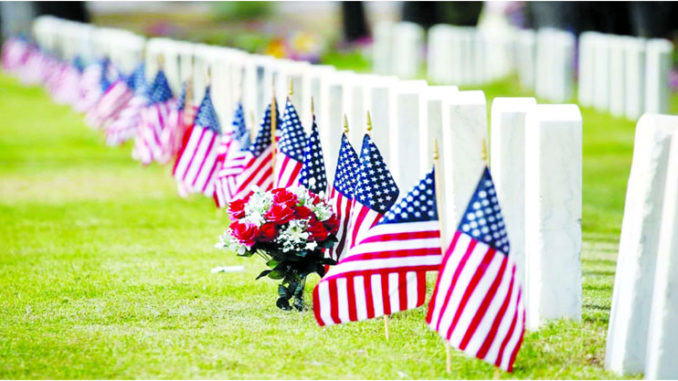
Memorial Day, May 31, for many Americans, conjures up images of hamburgers, hot dogs, swimming pools, and summertime . But the last Monday in May serves, most importantly, as a time to honor those who died while fighting in the U.S. Armed Forces. It’s a holiday steeped in somber American history and tradition. The day actually began as “Decoration Day,” following the Civil War, when mourners placed flowers on the graves of Union and Confederate soldiers. Yes, Memorial Day has also come to signify the “unofficial” start of summer, but let’s remember the heroes who made it all possible.
HISTORY OF MEMORIAL DAY
The Civil War ended in the spring of 1865 when Robert E. Lee surrendered the last major Confederate army to Ulysses S. Grant at the Appomattox Courthouse onmApril 9. Over 620,000 soldiers died in the four-year conflict. Gen. John A. Logan of the Grand Army of the Republic (an organization of Union veterans) would eventually select May 30, 1868, as a day to pay tribute to the fallen: “The 30th of May, 1868, is designated for the purpose of strewing with flowers, or otherwise decorating the graves of comrades who died in defense of their country during the late rebellion, and whose bodies now lie in almost every city, village and hamlet churchyard in the land…” Logan apparently chose May 30 because flowers would be in bloom all over the country. By the end of the 19th century, Memorial Day ceremonies were being held on May 30 throughout the nation. States passed proclamations, and the Army and Navy adopted rules for proper observance at their facilities.
The crowd attending the first Memorial Day ceremony at Arlington National Cemetery was approximately the same size as those that attend today’s observance, about 5,000 people. Then, as now, small American flags were placed on each grave — a tradition followed at many national cemeteries today. In recent years, the custom has grown in many families to decorate the graves of all departed loved ones.
By 1890 each Northern state had made Decoration Day an official holiday. Not so for the South, where states continued to honor their dead on separate days until after the first World War.
The May 30 date held for decades. But in 1968 Congress passed the Uniform Monday Holiday Act, which established Memorial Day as the last Monday in May in order to create a three-day weekend for federal employees. The change took place in 1971. The same law also declared Memorial Day a federal holiday.
TRADITIONS OF THE DAY
Many Americans observe Memorial Day by visiting cemeteries or memorials, holding family gatherings, and participating in parades. It’s the three-day weekend that kicks off the summer season and the time for hanging at the beach and lakes, and barbecuing with friends and family. But Memorial Day is also the most solemn American holiday — a day to remember those who made the ultimate sacrifice while defending their nation.
Towns and cities across the country host grand Memorial Day parades every year, often featuring senior veterans and military personnel. Some of the biggest parades take place in New York, Chicago, and Washington, D.C. Cemeteries and memorials are also visited by Americans, with some citizens wearing or holding red poppies to symbolize those who have fallen in war. This tradition has been around since World War I. Weekend trips and parties are also arranged to balance out the somberness of the day and welcome the summer.
HOW TO OBSERVE THE DAY?
Pay your respects
Lay flowers on the grave of a family member or friend who died while serving. If you don’t personally know any fallen soldiers, visit a local cemetery anyway. After all, you would not be here if it weren’t for their sacrifice. Participate in the National Moment of Remembrance
By doing so, you’ll be joining millions of Americans in national unity to honor Memorial Day for what it truly is — a day for those who made the ultimate sacrifice.
Fly the flag
If you have an American flag at home, be sure to fly it at half-mast until noon, then raise it to full mast for the rest of the day. The practice of lowering and then raising the flag has been observed for over 100 years to symbolize America’s persistence in the face of loss.
CREATIVE WAYS TO DECORATE FOR MEMORIAL DAY
Unfurl those flags
Often people store their American flags and raise them only during patriotic holidays. This is definitely one of those days.
Line your walkway with mini flags
Nothing honors our deceased veterans like dozens (or even hundreds) of flags in your front lawn and entryway.
Red, white, and blue layered cake
It’s a decoration you can eat.
Stars and Stripes windsocks
It’s festive, fun, and patriotic.
Symbolic flowers
Even if you haven’t lost a loved one who served in the military, you can still honor the fallen with flowers at home. Red, navy, and blue dahlias combined with white rose silk flowers can make a stunning visual combination.
WHY MEMORIAL DAY IS IMPORTANT?
Reflection
While the outdoor grilling, parades, and beautiful summer weather are some of our favorite perks of Memorial Day, the last Monday in May is the best time of year to quietly reflect on the men and women who made the ultimate sacrifice for our country. They make us feel inspired and challenged to be better— and that’s a wonderful feeling!
Summer — almost
We know, we know — summer officially begins on June 21. But in the minds of all Americans, summer actually begins on Memorial Day. That means it’s totally okay to dust off the grill, fill up the pool, and unplug.
Family
Since Memorial Day is a federal holiday with a built-in three-day weekend, we have an extra day to catch up on quality time with family members. For those of us with relatives who died while serving in the military, Memorial Day is sacred.
From its Civil War origins to its modern-day traditions
While the first commemorative Memorial Day events weren’t held in the United States until the late 19th century, the practice of honoring those who have fallen in battle dates back thousands of years. The ancient Greeks and Romans held annual days of remembrance for loved ones (including soldiers) each year, festooning their graves with flowers and holding public festivals and feasts in their honor. In Athens, public funerals for fallen soldiers were held after each battle, with the remains of the dead on display for public mourning before a funeral procession took them to their internment in the Kerameikos, one of the city’s most prestigious cemeteries. One of the first known public tributes to war dead was in 431 B.C., when the Athenian general and statesman Pericles delivered a funeral oration praising the sacrifice and valor of those killed in the Peloponnesian War—a speech that some have compared in tone to Abraham Lincoln’s Gettysburg Address.
As the Civil War neared its end, thousands of Union soldiers, held as prisoners of war, were herded into a series of hastily assembled camps in Charleston, South Carolina. Conditions at one camp, a former racetrack near the city’s Citadel, were so bad that more than 250 prisoners died from disease or exposure, and were buried in a mass grave behind the track’s grandstand.
Three weeks after the Confederate surrender, an unusual procession entered the former camp: On May 1, 1865, more than 1,000 people recently freed from enslavement, accompanied by regiments of the U.S. Colored Troops (including the Massachusetts 54th Infantry) and a handful of white Charlestonians, gathered in the camp to consecrate a new, proper burial site for the Union dead. The group sang hymns, gave readings and distributed flowers around the cemetery, which they dedicated to the “Martyrs of the Race Course.”
It didn’t become a federal holiday until 1971
American’s embraced the notion of “Decoration Day” immediately. That first year, more than 27 states held some sort of ceremony, with more than 5,000 people in attendance at a ceremony at Arlington National Cemetery. By 1890, every former state of the Union had adopted it as an official holiday. But for more than 50 years, the holiday was used to commemorate those killed just in the Civil War, not in any other American conflict. It wasn’t until America’s entry into World War I that the tradition was expanded to include those killed in all wars, and Memorial Day was not officially recognized nationwide until the 1970s, with America deeply embroiled in the Vietnam War.
long road from Decoration Day to an official Memorial Day
Although the term Memorial Day was used beginning in the 1880s, the holiday was officially known as Decoration Day for more than a century, when it was changed by federal law. Four years later, the Uniform Monday Holiday Act of 1968 finally went into effect, moving Memorial Day from its traditional observance on May 30 (regardless of the day of the week), to a set day—the last Monday in May. The move has not been without controversy, though. Veterans groups, concerned that more Americans associate the holiday with first long weekend of the summer and not its intended purpose to honor the nation’s war dead, continue to lobby for a return to the May 30 observances. For more than 20 years, their cause was championed by Hawaiian Senator—and decorated World War II veteran—Daniel Inouye, who until his 2012 death reintroduced legislation in support of the change at the start of every Congressional term.
More than 20 towns claim to be the holiday’s ‘birthplace’—but only one has federal recognition.
For almost as long as there’s been a holiday, there’s been a rivalry about who celebrated it first. Boalsburg, Pennsylvania, bases its claim on an 1864 gathering of women to mourn those recently killed at Gettysburg. In Carbondale, Illinois, they’re certain that they were first, thanks to an 1866 parade led, in part, by John Logan who two years later would lead the charge for an official holiday. There are even two dueling Columbus challengers (one in Mississippi, the other in Georgia) who have battled it out for Memorial Day supremacy for decades. Only one town, however, has received the official seal of approval from the U.S. government. In 1966, 100 years after the town of Waterloo, New York, shuttered its businesses and took to the streets for the first of many continuous, community-wide celebrations, President Lyndon Johnson signed legislation, recently passed by the U.S. Congress, declaring the tiny upstate village the “official” birthplace of Memorial Day.





Be the first to comment